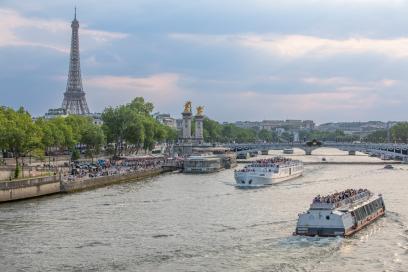- ABOUT US
- GOODS
- A multi-sector focus
- A maritime service offering in the first rank
- An attractive multimodal offering
- An expanded shortsea service offering
- Terminaux portuaires et quais à usage partagé
- High-quality ship services
- Fluid, facilitated goods throughput
- A port that puts its performance figures in the public domain
- PASSENGERS
- MULTIMODALITY
- ECOLOGICAL TRANSITION
- INNOVATION
The Seine at the heart of Games logistics
- the athletes' village was built alongside the quay, thanks to river transport and the ports of the Paris region, which were used to transport construction materials and site debris materials and sand supply Olympics worksites with materials;
- transport of the Official countdown clock was organized from the Gennevilliers multimodal platform to the Quai de la Bourdonnais, at the foot of the Eiffel Tower: an exceptional 9-tonne convoy on the ZULU03 barge;
- a spectacular exercise organized in the summer of 2023 to prepare for the opening ceremony parade and the test of the open-water events.
For HAROPA PORT, preparing for the Games also means:
- piping work and the installation of connection points to collect wastewater from floating installations; the aim is to improve water quality ;
- the provision of quays, river port facilities and logistics space on the Gennevilliers multimodal platform;
- safe navigation for the 116 boats that will sail along 6 km of the Seine, between the Pont d'Austerlitz and the Pont d'Iéna.
Continuing the "Seine challenge"
From the open-water events which preview that foreshadow bathing swimming for all... to the Olympic Village, which will become a new district open to the river, HAROPA PORT aims to extend the Seine's challenge by continuing to showcase all its uses and functions:
- a living environment, a landscape, a place for walking, entertainment and leisure;
- a natural environment for which the port has obligations to preserve and maintain ecological continuity;
- an outlet for rainwater and wastewater, the treatment and control of which must continue to improve;
- a water resource to meet a wide range of needs: agricultural irrigation, drinking water production, industrial use (such as the hydrogen's production by electrolysis of water);
- a viable, environmentally-friendly and unsaturated transport infrastructure for freight and cruise/leisure activities.
Good to know: shifting a truck's cargo to the river cuts road transport-related CO² emissions by 60%, and reduces road congestion
